Diptera Dwelling Aquatic and Terrestrial Habitats in an Alpine Floodplain (Amola Glacier, Italian Alps)
Simple Summary
Abstract
1. Introduction
2. Materials and Methods
2.1. Study Area
2.2. Sampling Schedule
- “biweekly sampling”: approximately every 15 days (at intervals varying from a minimum of 11 to a maximum of 20 days), between 7 July and 26 September, the Malaise and emergence traps were emptied, a kick semi-quantitative sample and one drift sample were collected in each site.
- “time sampling”: occurred twice and lasted 4 days each time: 23–26 July and 10–13 September. The samples were collected every 3 h between 6 AM and 9 PM for a total of 6 samples per day and 18 for each campaign. Time sampling was carried out using the drift net and the two traps.
2.2.1. Emergence and Malaise Traps
2.2.2. Pond and Drift Nets
2.3. Diptera Identification and Data Analysis
3. Results
3.1. Dipteran Fauna Composition
3.2. Seasonal Samplings
3.2.1. Emergence Traps and Malaise Trap
3.2.2. Kick Samplings
3.3. “Time” Samplings
4. Discussion
4.1. Diptera Distribution and Phenology
4.2. Ecological Notes of Brachycera Species
5. Conclusions
Supplementary Materials
Author Contributions
Funding
Data Availability Statement
Acknowledgments
Conflicts of Interest
Appendix A
- LONCHOPTERIDAE
- RECORDS:
- 26.VII-6.VIII, 1F (emergence trap site B), 6FF (Malaise trap); 6-26.VIII, 5FF (Malaise trap); 26.VIII-10.IX, 1F (Malaise trap); 13-26.IX, 1F (emergence trap site B).
- 13-26.IX, 1F (emergence trap site A), 2MM 2FF (emergence trap site B).
- SYRPHIDAE
- RECORDS:
- 7-23.VII, 1M; 25.VII, (3:00 PM) 1M; 26.VII-6.VIII, 1F (all Malaise trap).
- 7-23.VII, 1F (Malaise trap).
- 26.VIII-10.IX, 1F (Malaise trap).
- 7-23.VII, 1F (Malaise trap).
- 6-26.VIII, 1F (Malaise trap).
- 7-23.VII, 1M 1F (Malaise trap).
- 7-23.VII, 1M (Malaise trap).
- 7-23.VII, 1F (Malaise trap).
- 7-23.VII, 1F; 26.VII-6.VIII, 1F (all Malaise trap).
- 7-23.VII, 2MM (Malaise trap).
- TEPHRITIDAE
- RECORDS:
- 7-23.VII, 1F (Malaise trap).
- 26.VIII-10.IX, 1F (Malaise trap).
- SEPSIDAE
- RECORDS:
- 24.VII, 1F (Malaise trap).
- 7-23.VII, 1M 2FF (Malaise trap).
- 6-26.VIII, 1M (Malaise trap), 1F (emergence trap site A); 13-26.IX, 2FF (emergence trap site A).
- HELEOMYZIDAE
- RECORDS:
- 7-23.VII, 1F (Malaise trap); 26.VII-6.VIII, 1F (Malaise trap); 13-26.IX, 1F (emergence trap site B).
- 7-23.VII, 1F; 26.VII, (6 AM) 1F; 26.VII-6.VIII, 1M, 2FF; 6-26.VIII, 1M (all Malaise trap).
- 7-23.VII, 1F (emergence trap site A); 7-23.VII, 1M 4FF (Malaise trap); 23.VII, 2MM 1F (Malaise trap 9 PM); 24.VII, 1F (Malaise trap 12 AM); 24.VII, 2MM 3FF (Malaise trap 6 PM); 24.VII, (9 PM) 4FF (Malaise trap); 25.VII, (9 PM) 1F (Malaise trap); 26.VII-6.VIII, 1F (emergence trap site A), 3FF (emergence trap site B), 7MM 14FF (Malaise trap); 6-26.VIII, 18 FF (Malaise trap), 2FF (emergence trap site B); 26.VIII-10.IX, 1F (emergence trap site A).
- 7-23.VII, 1F (Malaise trap); 24.VII, (6 AM) 1M 1F (Malaise trap); 26.VII, (12 AM) 1F (Malaise trap); 26.VII-6.VIII, 4MM 9FF (Malaise trap); 26.VIII-10.IX, 1M 4F (Malaise trap); 26.VIII-10.IX, 1F (emergence trap site A).
- 13-26.IX, 1M (emergence trap site B).
- 7-23.VII, 1M (Malaise trap).
- 6-26.VIII, 2FF (Malaise trap).
- 6-26.VIII, 2FF (Malaise trap); 26.VII-6.VIII, 1F (emergence trap site B).
- MUSCIDAE
- RECORDS:
- 7.VII-23.VII, 2MM 1F (Malaise trap); 26.VII-6.VIII, 1M (emergence trap site A); 6-26.VIII, 1F (Malaise trap).
- 7.VII-23.VII, 8MM 18FF; 23.VII, (6 PM) 1F; 24.VII, (12:00 AM) 1M; 25.VII, (12 AM) 1M; 1F; 26.VII-6.VIII, 1M 3FF; 6-26.VIII, 1F (all Malaise trap).
- 24.VII, (12 AM) 1M; 25.VII, 1M (all Malaise trap).
- 26.VII-6.VIII, 1M 3FF (Malaise trap).
- 6-26.VIII, 1F (Malaise trap).
- 7-23.VII, 1M; 24.VII, (6 AM) 1F; 26.VII-6.VIII, 1M 1F; 6-26.VIII, 1F; 26.VIII-10.IX, 1M (all Malaise trap).
- 7-23.VII, 1F (Malaise trap).
- 7-23.VII, 4MM 4FF; 23.VII, (6 PM) 1F; 24.VII, (12 AM) 1F; 26.VII-6.VIII, 2FF; 6-26.VIII, 2MM (all Malaise trap).
- 7-23.VII, 1M 1F (Malaise trap).
- 7-23.VII, 1M (Malaise trap).
- 26.VII-6.VIII, 1F; 6-26.VIII, 1F (all Malaise trap).
- 6-26.VIII, 1F (Malaise trap).
- 26.VII-6.VIII, 1M; 6-26.VIII, 1M (all Malaise trap).
- 7-23.VII, 4MM 7FF; 24.VII, (6:00 PM) 1F (all Malaise trap).
- 7.VII-23.VII 2MM (Malaise trap).
- 26.VII-6.VIII, 1M (Malaise trap).
- 7-23.VII, 4MM 4FF; 26.VII-6.VIII, 2MM; 6-26.VIII, 1F (all Malaise trap).
- 7-23.VII, 2FF; 26.VII, (3 PM) 1M (all Malaise trap).
- 13-26.IX, 1F (emergence trap site A).
- 7-23.VII, 2MM 3FF; 6-26.VIII, 1M 1F (all Malaise trap).
- 7-23.VII, 2MM 12FF; 26.VII-6.VIII, 4FF (all Malaise trap).
- 7-23.VII, 1M 4FF (Malaise trap); 24.VII, (6:00 PM) 1M 1F (Malaise trap); 26.VII, 1F (Malaise trap); 26.VII-6.VIII, 1F (emergence trap site B), 2FF (Malaise trap); 6-26.VIII, 1M (Malaise trap).
- 6-26.VIII, 1F; 26.VIII-10.IX, 1F (all emergence trap site A).
- 7-23.VII, 3MM 2FF; 24.VII, (6 PM) 1F; 26.VII, (6:00 AM) 1M, (12 AM) 1M, (3 PM) 1F; 26.VII-6.VIII, 6MM 5FF (all Malaise trap).
- 7-23.VII, 2MM 5FF (Malaise trap).
- 7-23.VII, 8MM 5FF (Malaise trap); 24.VII, (6:00 PM) 2FF (Malaise trap); 25.VII, (6 PM) 1F (Malaise trap); 26.VII-6.VIII, 4FF 1M (Malaise trap), 1F (emergence trap site B); 6-26.VIII, 2FF (Malaise trap).
- 7-23.VII, 1F (emergence trap site A), 13MM 11FF (Malaise trap); 23.VII, (6 PM) 2FF (Malaise trap); 24.VII, (6 AM) 1F, (12 AM) 1M 1F, (6 PM) 1F, (9 PM) 2MM 3FF (Malaise trap); 25.VII, (9 PM) 2FF (Malaise trap); 26.VII, (12 AM) 1F (Malaise trap); 26.VII-6.VIII, 19MM 28FF (Malaise trap); 6-26.VIII, 1F (emergence trap site A), 1F (emergence trap site B), 6MM 21FF (Malaise trap); 26.VIII-10.IX, 2FF (emergence trap site A), 1M 16FF (Malaise trap); 13-26.IX, 1F (emergence trap site B), 2FF (Malaise trap).
- 7-23.VII, 1M; 23.VII, (9 PM) 1M (all Malaise trap).
- 7-23.VII, 3MM; 24.VII, (12 AM) 1M, (6 PM) 2FF; 25.VII, (6 PM) 1M; 26.VII-6.VIII, 2MM 2FF; 6-26.VIII, 1M 2FF (all Malaise trap).
- 7-23.VII, 4FF; 24.VII, (6 PM) 1F; 26.VII-6.VIII, 16FF; 6-26.VIII, 3FF (all Malaise trap).
- 7-23.VII, 1F (Malaise trap); 25.VII, (12 AM) 1F (Malaise trap); 26.VII, (6 AM) 1F, (12 AM) 1F (Malaise trap); 26.VII-6.VIII, 1F (emergence trap site B), 1MM 4FF (Malaise trap).
- 26.VII-6.VIII, 1F (Malaise trap).
- 6-26.VIII, 1F (Malaise trap).
- 7-23.VII, 1F (Malaise trap); 6-26.VIII, 1F (emergence trap site B).
- TACHINIDAE
- RECORDS:
- 7-23.VII, 1M 1F; 26.VII-6.VIII, 1F (all Malaise trap).
- 6-26.VIII, 1M (Malaise trap).
References
- Lencioni, V. Survival strategies of freshwater insects in cold environments. J. Limnol. 2004, 63, 45–55. [Google Scholar] [CrossRef]
- Lencioni, V.; Jousson, O.; Guella, G.; Bernabo, P. Cold adaptive potential of chironomids overwintering in a glacial stream. Physiol. Entomol. 2015, 40, 43–53. [Google Scholar] [CrossRef]
- Wilkes, M.; Carrivick, J.; Castella, E.; Ilg, C.; Cauvy-Fraunié, S.; Fell, S.; Füreder, L.; Huss, M.; James, W.; Lencioni, V.; et al. Glacier retreat reorganizes river habitats leaving refugia for Alpine invertebrate biodiversity poorly protected. Nat. Ecol. Evol. 2023, 7, 841–851. [Google Scholar] [CrossRef] [PubMed]
- Bonelli, M.; Eustacchio, E.; Avesani, D.; Michelsen, V.; Falaschi, M.; Caccianiga, M.; Gobbi, M.; Casartelli, M. The Early Season Community of Flower-Visiting Arthropods in a High-Altitude Alpine Environment. Insects 2022, 13, 393. [Google Scholar] [CrossRef]
- Losapio, G.; Gobbi, M.; Marano, G.; Avesani, D.; Boracchi, P.; Compostella, C.; Pavesi, M.; Schöb, C.; Seppi, R.; Sommaggio, D.; et al. Feedback effects between plant and flower-visiting insect communities along a primary succession gradient. Arthropod-Plant Interact. 2016, 10, 485–495. [Google Scholar] [CrossRef]
- Warren, S.D.; Harper, K.T.; Booth, G.M. Elevational Distribution of Insect Pollinators. Am. Midl. Nat. 1988, 120, 325–330. Available online: https://www.jstor.org/stable/2426004 (accessed on 24 August 2024). [CrossRef]
- Blagoderov, V.; Mostovski, M.B. Order Diptera Linnaeus, 1758. In Animal Biodiversity: An Outline of Higher-Level Classification and Survey of Taxonomic Richness; Zhang, Z.Q., Ed.; Zootaxa; Magnolia Press: Auckland, New Zealand, 2011; Volume 3148, pp. 222–229. [Google Scholar]
- Courtney, G.W.; Cranston, P.S. Order Diptera. In Thorp and Covich’s Freshwater Invertebrates, 4th ed.; Thorp, J.H., Rogers, D.C., Eds.; Academic Press: London, UK, 2015; Volume 1, pp. 1043–1058. [Google Scholar]
- Courtney, G.W.; Pape, T.; Skevington, J.H.; Sinclair, B.J. Biodiversity of Diptera. In Insect Biodiversity: Science and Society, 2nd ed.; Foottit, R.G., Adler, P.H., Eds.; John Wiley & Sons Ltd.: Chichester, UK, 2017; Volume I, pp. 229–278. [Google Scholar]
- Adler, P.H.; Foottit, R.G. Introduction. In Insect Biodiversity: Science and Society, 2nd ed.; Foottit, R.G., Adler, P.H., Eds.; John Wiley & Sons Ltd.: Chichester, UK, 2017; Volume I, pp. 1–7. [Google Scholar]
- Lencioni, V.; Adler, P.H.; Courtney, G.W. Order Diptera. In Identification and Ecology of Freshwater Arthropods in the Mediterranean Basin; Maasri, A., Thorp, J.H., Eds.; Elsevier: Amsterdam, The Netherlands, 2024; Chapter 15; pp. 503–535+633–639. [Google Scholar]
- Avesani, D.; Lencioni, V. I Ditteri. In La Fauna dei Prati; Gobbi, M., Latella, L., Eds.; Museo delle Scienze: Trento, Italy, 2011; pp. 37–172. [Google Scholar]
- Brown, L.E.; Khamis, K.; Wilkes, M.; Blaen, P.; Brittain, J.E.; Carrivick, J.L.; Fell, S.; Friberg, N.; Rureder, L.; Gislason, G.M.; et al. Functional diversity and community assembly of river invertebrates show globally consistent responses to decreasing glacier cover. Nat. Ecol. Evol. 2018, 2, 325–333. [Google Scholar] [CrossRef]
- Gobbi, M.; Maffioletti, M.; Losapio, G.; Tampucci, D.; Isaia, M.; Ballarin, F.; Compostella, C.; Seppi, R.; Caccianiga, M. Life in harsh environments: Carabid and spider trait types and functional diversity on a debris-covered glacier and along its foreland. Ecol. Entomol. 2017, 42, 838–848. [Google Scholar] [CrossRef]
- Losapio, G.; Jordán, F.; Caccianiga, M.; Gobbi, M. Structure-dynamic relationship of plant-insect networks along a primary succession gradient on a glacier foreland. Ecol. Model. 2015, 314, 73–79. [Google Scholar] [CrossRef]
- Tenan, S.; Maffioletti, C.; Caccianiga, M.; Compostella, C.; Seppi, R.; Gobbi, M. Hierarchical models for describing space-for-time variations in insect population size and sex-ratio along a primary succession. Ecol. Model. 2016, 329, 18–28. [Google Scholar] [CrossRef]
- Lencioni, V. Glacial influence and macroinvertebrate biodiversity under climate change: Lessons from the Southern Alps. Sci. Total Environ. 2018, 622–623, 563–575. [Google Scholar] [CrossRef] [PubMed]
- Lencioni, V.; Gobbi, M. Are carabids (Coleoptera: Carabidae) and chironomids (Diptera: Chironomidae) experiencing similar diversity and distributional patterns along a glacier forelands? J. Limnol. 2018, 77, 187–195. [Google Scholar] [CrossRef]
- Jud, P.; Schmidt-Entling, M.H. Fluid type, dilution, and bitter agent influence spider preservation in pitfall traps. Entomol. Exp. Appl. 2008, 129, 356–359. [Google Scholar] [CrossRef]
- Oosterbroek, P. The European Families of the Diptera; KNNV Publishing: Utrecht, The Netherlands, 2006; pp. 1–206. [Google Scholar]
- Whittington, A.E.; Beuk, P.L.T. A description of a new species of Western Palaearctic Lonchoptera Meigen (Diptera, Lonchopteridae) from Georgia. ZooNova. Occas. Pap. Zool. 2022, 20, 1–18. [Google Scholar]
- Online Identification Keys—Lonchopteridae of Europe (P.L.Th. Beuk). Available online: https://www.online-keys.net/infusions/keys/keys_print.php?key_no=27 (accessed on 8 August 2024).
- Collin, J.E. The British species of Heleomyzidae (Diptera). Entomol. Mon. Mag. 1943, 79, 234–251. [Google Scholar]
- Czerny, L. Monographie der Helomyziden. Abh. Der Zool.-Bot. Ges. Wien 1924, 15, 1–166. [Google Scholar]
- Gorodkov, K.B. Family Helomyzidae (Heleomyzidae). In Keys to the Insects of the European Part of the USSR. Volume 5. Diptera and Siphonaptera Part II; Bei-Bienko, G.Y., Steyskal, G.C., Eds.; Brill: Leiden, The Netherlands, 1989; pp. 510–537. [Google Scholar]
- Papp, L. 54. Család. Heleomyzidae—Tüskésszárnyú legyek. Fauna Hung. 1981, 15, 1–77. [Google Scholar]
- Woźnica, A.J. Suillia crinimana (Czerny, 1904), a heleomyzids fly species of the tribe Suilliini Bezzi, 1911, new to the Polish fauna (Diptera: Heleomyzidae). Dipteron 2006, 22, 20–22. [Google Scholar]
- Speight, M.C.D.; Sarthou, J.-P. StN keys for the identification of adult European Syrphidae (Diptera) 2013/Clés StN pour la détermination des adultes des Syrphidae Européens (Diptères) 2013. In Syrph the Net, the database of European Syrphidae; Syrph the Net Publications: Dublin, Ireland, 2013; Volume 74, pp. 1–133. [Google Scholar]
- Merz, B. Diptera, Tephritidae. Insecta Helv. Fauna 1994, 10, 1–198. [Google Scholar]
- Pont, A.C.; Meier, R. The Sepsidae (Diptera) of Europe. Fauna Entomol. Scand. 2002, 37, 1–221. [Google Scholar]
- Gregor, F.; Rozkošný, R.; Barták, M.; Vaňhara, J. Manual of Central European Muscidae (Diptera). Morphology, taxonomy, identification, and distribution. Zoologica 2016, 162, 1–219. [Google Scholar]
- Hennig, W. 63b Muscidae. In Die Fliegen der Palaearktischen Region; Lindner, E., Ed.; Part 1; E. Schweizerbartsche Verlagsbuchhandlung: Stuttgart, Germany, 1964; Volume 7, pp. 1–624. [Google Scholar]
- Hennig, W. 63b Muscidae. In Die Fliegen der Palaearktischen Region; Lindner, E., Ed.; Part 2; E. Schweizerbartsche Verlagsbuchhandlung: Stuttgart, Germany, 1964; Volume 7, pp. 625–1110. [Google Scholar]
- Savage, J. Revision of the genus Thricops. Insect Syst. Evol. Suppl. 2003, 61, 1–143. [Google Scholar]
- Sinclair, B.J.; Cumming, J.M. The morphology, higher-level phylogeny and classification of the Empidoidea (Diptera). Zootaxa 2006, 1180, 1–172. [Google Scholar] [CrossRef]
- Tiusanen, M.; Hebert, P.D.N.; Schmidt, N.M.; Roslin, T. One fly to rule them all—Muscid flies are the key pollinators in the Arctic. Proc. R. Soc. B 2016, 283, 20161271. [Google Scholar] [CrossRef] [PubMed]
- Lundgren, R.; Olesen, J.M. The Dense and Highly Connected World of Greenland’s Plants and Their Pollinators. Arct. Antarct. Alp. Res. 2005, 37, 514–520. [Google Scholar] [CrossRef]
- Elberling, H.; Olesen, J.M. The Structure of a High Latitude Plant-Flower Visitor System: The Dominance of Flies. Ecography 1999, 22, 314–323. [Google Scholar] [CrossRef]
- Albrecht, M.; Riesen, M.; Schmid, B. Plant–pollinator network assembly along the chronosequence of a glacier foreland. Oikos 2010, 119, 1610–1624. [Google Scholar] [CrossRef]
- Ziegler, J. Diptera Stelviana: A Dipterological Perspective on a Changing Alpine Landscape; Studia Dipterologica. Supplement 16; Ampyx-Verlag: Halle (Saale), Germany, 2008; Volume 1, pp. 1–395. [Google Scholar]
- Ziegler, J. Diptera Stelviana: A Dipterological Perspective on a Changing Alpine Landscape; Studia Dipterologica. Supplement 21; Ampyx-Verlag: Halle (Saale), Germany, 2016; Volume 2, pp. 1–448. [Google Scholar]
- Preisler, J.; Roháček, J.; Michal, T. The fauna of Heleomyzidae (Diptera) in the Gemer area (Central Slovakia). Acta Mus. Siles. Sci. Natur. 2022, 71, 131–181. [Google Scholar] [CrossRef]
- Dvořáková -Marsová, K.; Martinek, V.; Barták, M.; Kubík, Š. Heleomyzidae. In Diptera of Podyjí National Park and Its Environs; Barták, M., Kubík, Š., Eds.; Česká zemědělská univerzita v Praze: Praha, Czech Republic, 2006; pp. 325–331. [Google Scholar]
- Wolf, B. Animalium Cavernarum Catalogus; W. Junk: Gravenhage, The Netherlands, 1938; pp. 1934–1938. [Google Scholar]
- Papp, L. Families of Heleomyzoidea. In Contribution to a Manual of Palaearctic Diptera (with Special Reference to Flies of Economic Importance). Higher Brachycera; Papp, L., Darvas, B., Eds.; Science Herald: Budapest, Hungary, 1998; Volume 3, pp. 425–455. [Google Scholar]
- Withers, P. The british species of the genus Suillia (Diptera, Heleomyzidae) including a species new to science. Proc. Trans. Br. Ent. Nat. Hist. Soc. 1987, 20, 91–104. [Google Scholar]
- Duarte, J.L.P.; Kruger, R.; De Carvalho, C.; Ribeiro, P. Evidence of the influence of Malaise trap age on its efficiency in the collection of Muscidae (Insecta, Diptera). Int. J. Trop. Insect Sci. 2010, 30, 115–118. [Google Scholar] [CrossRef]
- Pont, A.C. Muscidae. In Diptera Stelviana: A Dipterological Perspective on a Changing Alpine Landscape; Ziegler, J., Ed.; Studia Dipterologica. Supplement 16; Ampyx-Verlag: Halle (Saale), Germany, 2008; Volume 1, pp. 185–197. [Google Scholar]
- Krzemiñska, E. Key and atlas to the genus Trichocera Meigen in Europe (Diptera, Trichoceridae). Acta Zool. Cracoviensia 2021, 64, 1–157. [Google Scholar] [CrossRef]
- Dahl, C.; Krzemiñska, E. Trichoceridae. In Manual of Palaearctic Diptera; Papp, L., Béla, D., Eds.; Science Herald: Budapest, Hungary, 1997; Volume 2, pp. 227–237. [Google Scholar]
- Latella, L.; Brighenti, S. Exploring Ice Cave Biodiversity in Northeastern Italy. Diversity 2024, 16, 364. [Google Scholar] [CrossRef]
- Plachter, H. Cave-dwelling flies in Central Europe: Adaptation to environment, especially to low temperatures (Diptera, Nematocera: Trichoceridae et Sciaridae). Oecologia 1983, 58, 367–372. [Google Scholar] [CrossRef] [PubMed]
- Xu, X.; Ren, Z.-X.; Trunschke, J.; Kuppler, J.; Zhao, Y.H.; Knop, E.; Wang, H. Bimodal activity of diurnal flower visitation at high elevation. Ecol. Evol. 2021, 11, 13487–13500. [Google Scholar] [CrossRef]
- Woźnica, A.J. Heleomyzidae. In Diptera Stelviana: A Dipterological Perspective on a Changing Alpine Landscape; Ziegler, J., Ed.; Studia Dipterologica. Supplement 16; Ampyx-Verlag: Halle (Saale), Germany, 2008; Volume 1, pp. 178–184. [Google Scholar]
- Pont, A.C. Muscidae from above the Tree-line in the Upper Ötz Valley (Tyrol, Austria). Berichte Naturwissenschaftlich-Med. Ver. Innsbr. 1995, 82, 311–318. [Google Scholar]
- Drake, C.M. The distribution and habitat preferences of British Lonchoperidae (Diptera). Entomol. Mon. Mag. 2022, 138, 121–132. [Google Scholar]
- Bartak, M. Lonchopteridae. In Manual of Palaearctic Diptera; Papp, L., Béla, D., Eds.; Science Herald: Budapest, Hungary, 1998; Volume 3, pp. 13–16. [Google Scholar]
- Minelli, A.; Bologna, M.A. Sistematica ed Evoluzione Degli Esapodi; Liguori Editore: Napoli, Italy, 2023; pp. 1–648. [Google Scholar]
- Speight, M.C.D. StN keys for the identification of adult European Syrphidae (Diptera) 2020. In Syrph the Net, the Database of European Syrphidae; Syrph the Net publications: Dublin, Ireland, 2020; Volume 105, pp. 1–46. [Google Scholar]
- Mazzon, L.; Korneyev, V.; Insecta Diptera Tephritidae. In Checklist of the Italian Fauna; Bologna, M.A., Zapparoli, M., Oliverio, M., Minelli, A., Bonato, L., Cianferoni, F., Stoch, F., Eds.; 2021; Version 1.0. Available online: https://www.lifewatchitaly.eu/iniziative/checklist-fauna-italia-it/checklist-table/ (accessed on 6 July 2024).
- Lo Giudice, G.; Woźnica, A.J. An updated checklist of the Italian Heleomyzidae (Diptera: Sphaeroceroidea). Genus 2013, 24, 439–458. [Google Scholar]
- Woźnica, A.J. Heleomyzidae. In Fauna Europaea: Diptera: Brachycera. Fauna Europaea Version 2.6.2; Pape, T., Beuk, P., Eds.; Fauna Europaea Consortium Publisher: Copenhagen, Denmark, 2013. [Google Scholar]
- Martinek, V. Příspěvek k poznání některých dvoukřídlých (Diptera, Acalyptrata) v oblasti jižních Čech. A contribution to the knowledge of some Diptera (Acalyptrata) in the region of southern Bohemia. Sborník Jihočeského Muz. V Českých Budějovicích Přírodní Vědy 1971, 11, 77–92, (In Czech with English Summary). [Google Scholar]
- Martinek, V. Zajímavější druhy dvoukřídlého hmyzu z čeledi Helomyzidae (Diptera-Acalyptrata)v Krkonoších. More interesting species of two-wing insects from the family Helomyzidae (Diptera-Acalyptrata) in the Giant Mountains (Krkonoše). Opera Corcon. 1969, 6, 51–75, (In Czech, with English Summary). [Google Scholar]
- Wagner, R.; Barták, M.; Borkent, A.; Courtney, G.W.; Goddeeris, B.; Haenni, J.-P.; Knutson, L.; Pont, A.; Rotheray, G.E.; Rozkŏsný, R.; et al. Global diversity of dipteran families (Insecta Diptera) in freshwater (excluding Simulidae, Culicidae, Chironomidae, Tipulidae and Tabanidae). Hydrobiologia 2008, 595, 489–519. [Google Scholar] [CrossRef]
- Munari, L. Insecta Diptera Canacidae, Coelopidae, Helcomyzidae, Nannodastiidae, Sepsidae. In Checklist of the Italian Fauna; Bologna, M.A., Zapparoli, M., Oliverio, M., Minelli, A., Bonato, L., Cianferoni, F., Stoch, F., Eds.; 2021; Version 1.0. Available online: https://www.lifewatchitaly.eu/iniziative/checklist-fauna-italia-it/checklist-table/ (accessed on 6 July 2024).
- della Lessinia (Veneto). V. Sepsidae e Sphaeroceridae: Nuovi dati faunistici (Diptera, Acalyptratae). Lav. Soc. Ven. Sc. Nat. 1991, 16, 45–60, (In Czech with English summaryn Italian with English Summary). [Google Scholar]
- Munari, L. Studi sulla ditterofauna della Lessinia (Veneto). II. I Sepsidae della Lessinia centrale: Osservazioni faunistiche ed ecologiche. Notulae Sepsidologicae XI (Diptera, Cyclorrhapha). Lav. Soc. Ven. Sc. Nat. 1987, 12, 71–86, (In Italian with English Summary). [Google Scholar]
- Cerretti, P.; Tschorsnig, H.-P. Annotated host catalogue for the Tachinidae (Diptera) of Italy. Stuttg. Beiträge Zur Naturkunde A Neue Ser. 2010, 3, 305–340. [Google Scholar]
- Pont, A.C. Observations on anthophilous Muscidae and other Diptera (Insecta) in Abisko National Park, Sweden. J. Nat. Hist. 1993, 27, 631–643. [Google Scholar] [CrossRef]
- Bezzi, M. Studi sulla ditterofauna nivale delle Alpi italiane. In Memorie Della SOCIETÀ Italiana di Scienze Naturali e del Museo Civico di Storia Naturale di Milano; Biodiversity Heritage Library: Washington, WA, USA, 1918; Volume 9, pp. 1–164. [Google Scholar]
- Avesani, D.; Pont, A. Insecta Diptera Muscidae. In Checklist of the Italian Fauna; Bologna, M.A., Zapparoli, M., Oliverio, M., Minelli, A., Bonato, L., Cianferoni, F., Stoch, F., Eds.; 2021; Version 1.0. Available online: https://www.lifewatchitaly.eu/iniziative/checklist-fauna-italia-it/checklist-table/ (accessed on 24 August 2024).
- Haenni, J.P.; Pont, A.C. Muscidae and Fanniidae (Diptera) from the Alp Flix area (Swiss Alp, Grisons), with special reference to species from the alpine level. Jahresber. Der Naturforschenden Ges. Graubünden 2007, 114, 99–106. [Google Scholar]
- Rozkošný, R.; Gregor, F. Insecta: Diptera: Muscidae. In Süßwasserfauna von Mitteleuropa; Schwoerbel, J., Zwick, P., Eds.; Elsevier GmbH: München, Germany, 2004; Volume 29, pp. 1–111. [Google Scholar]
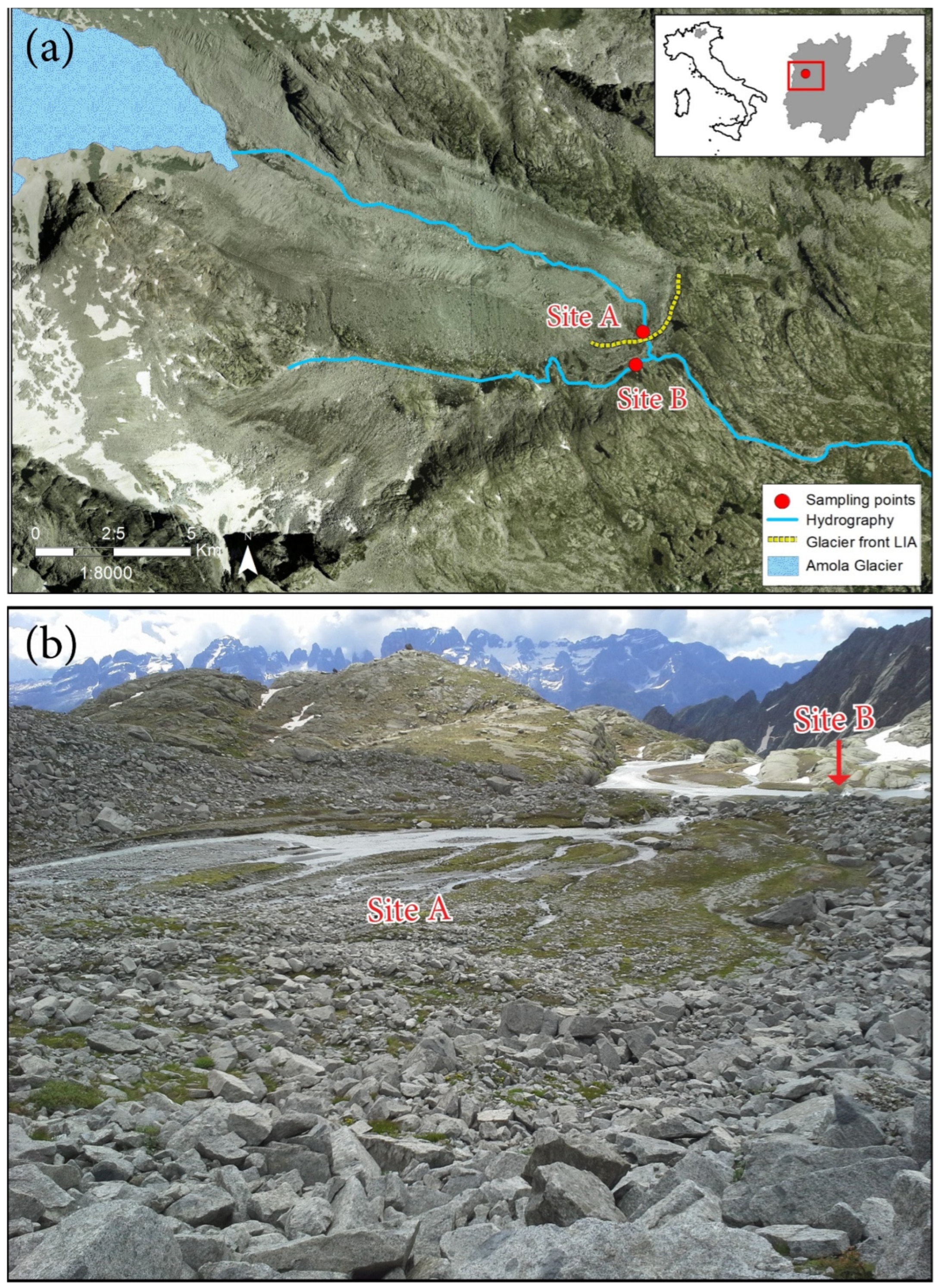
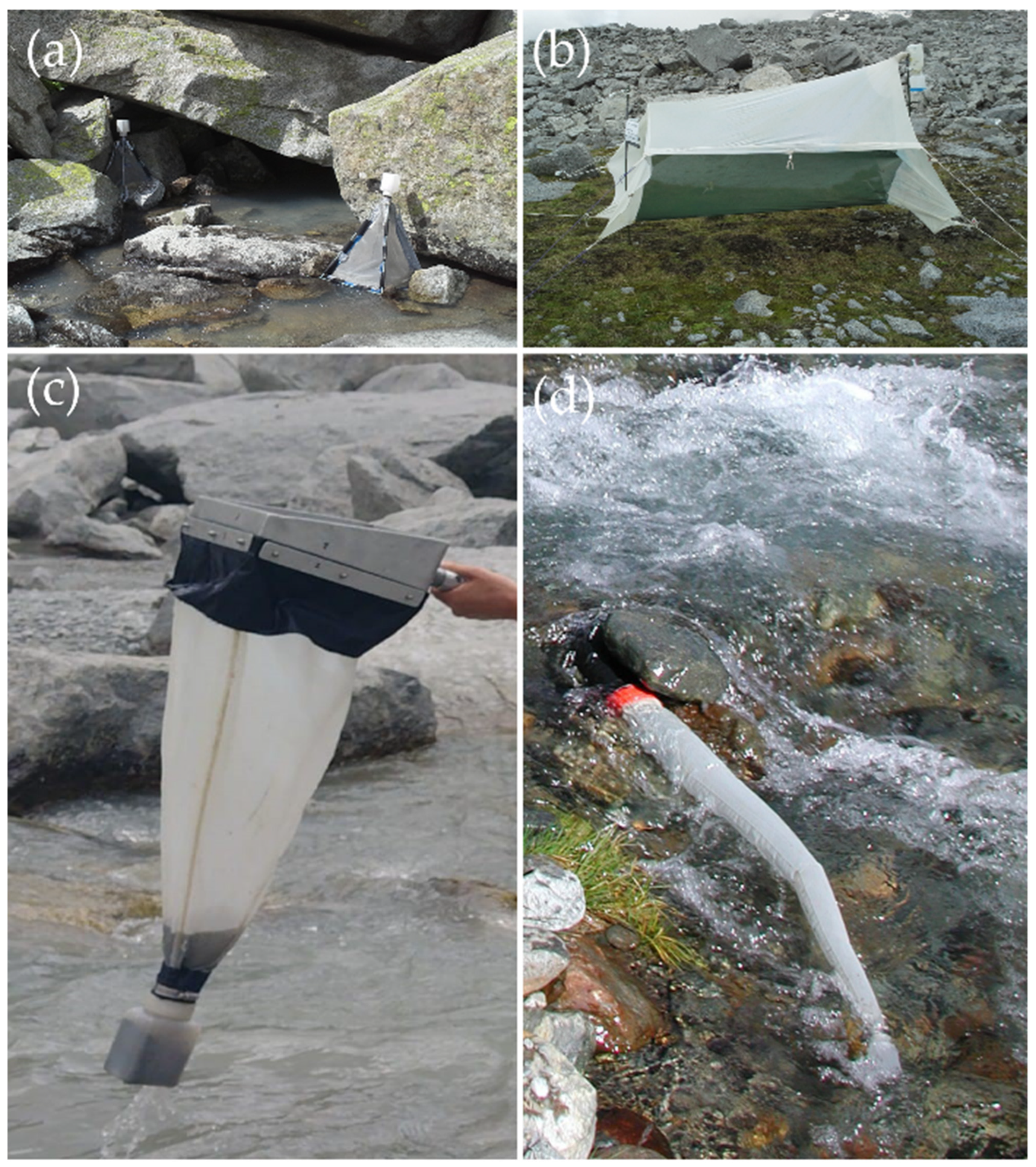
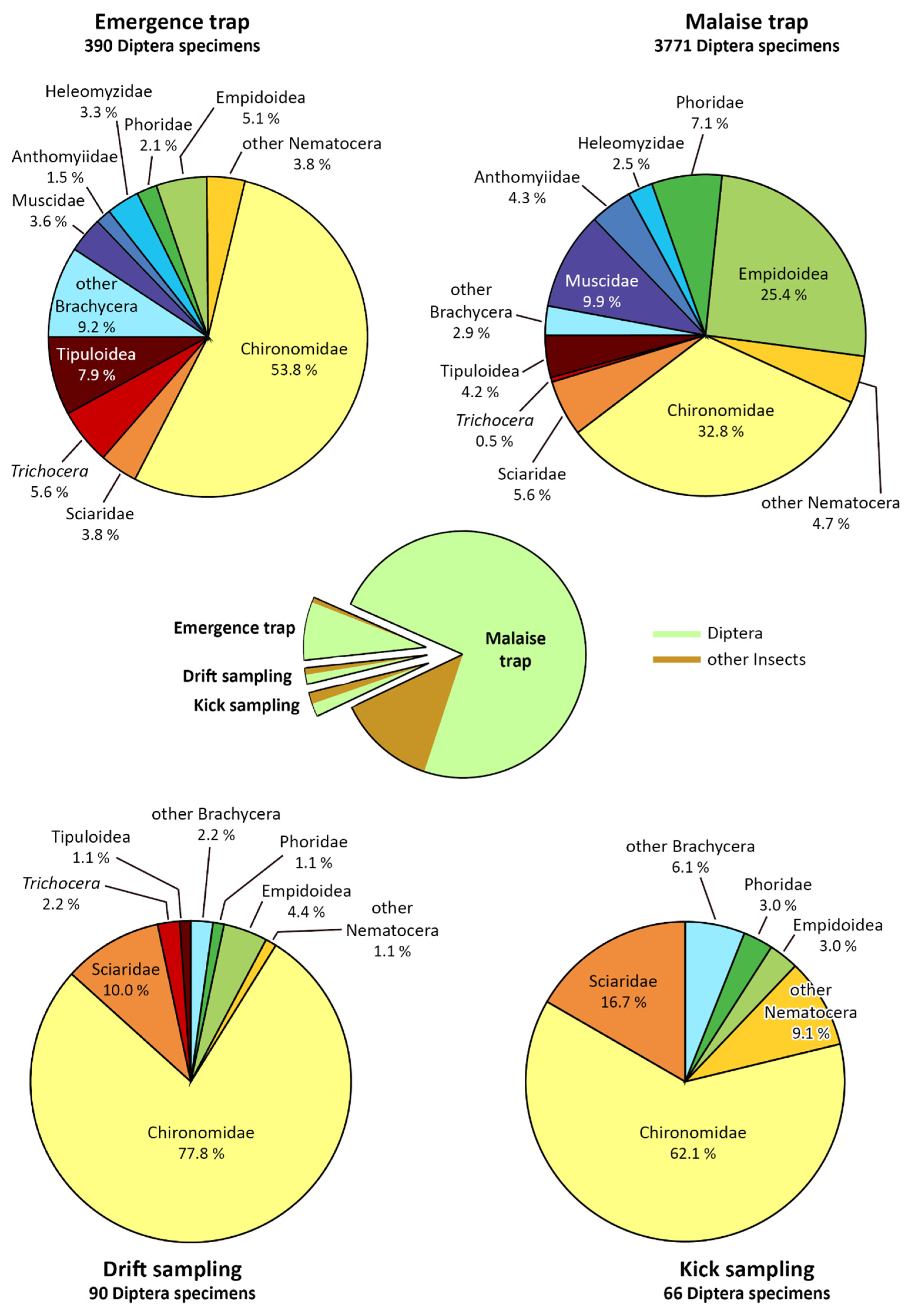
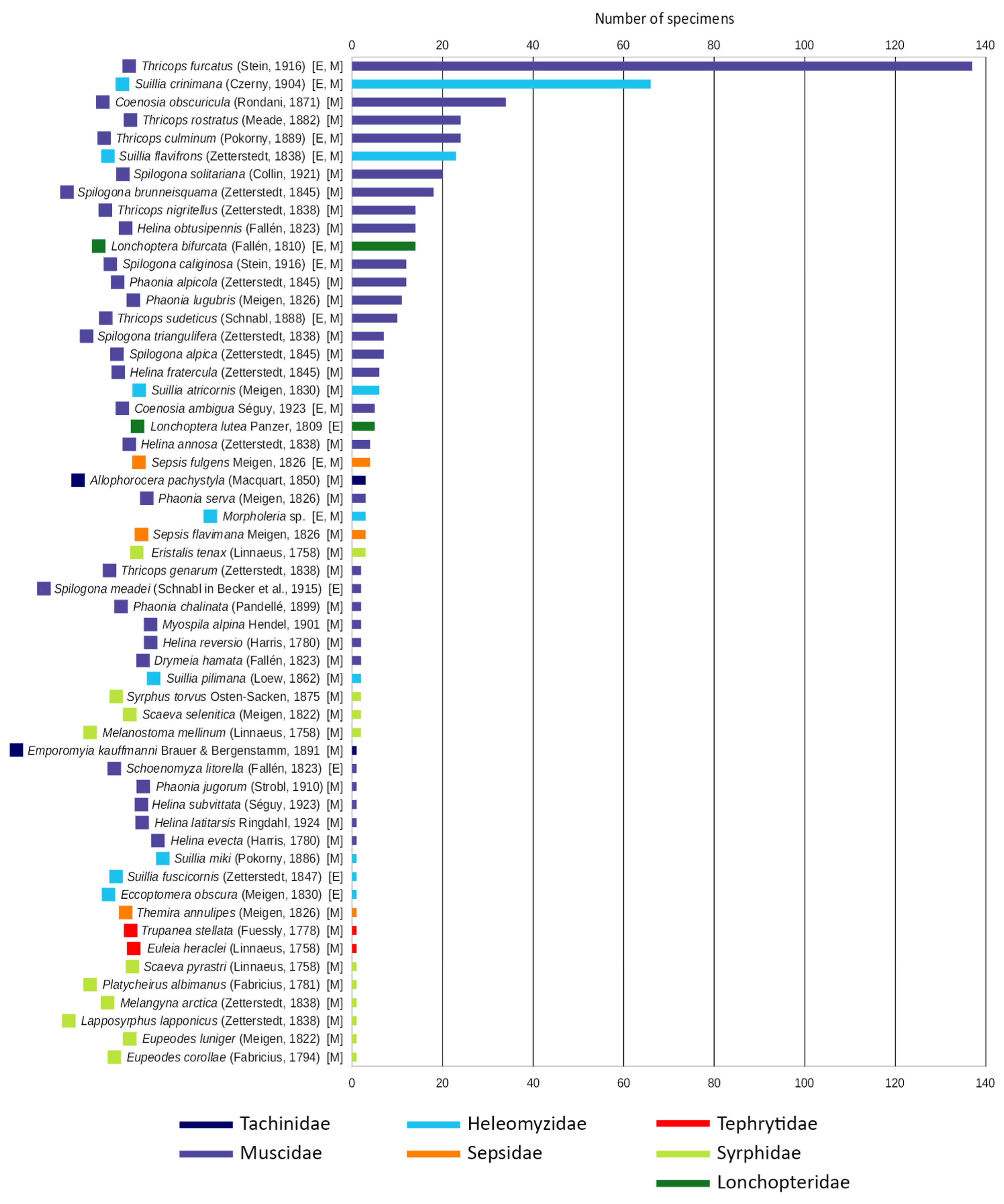
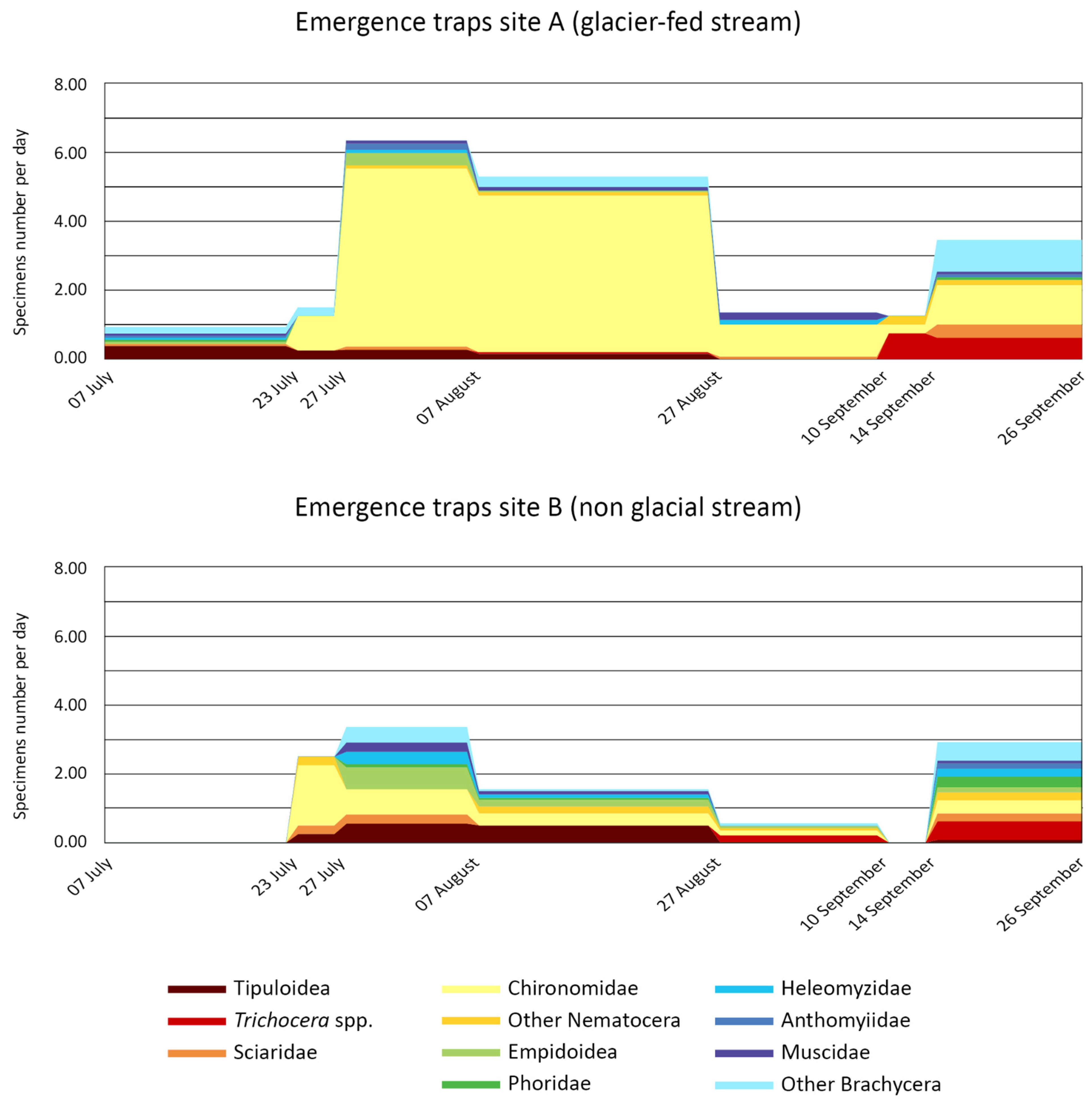
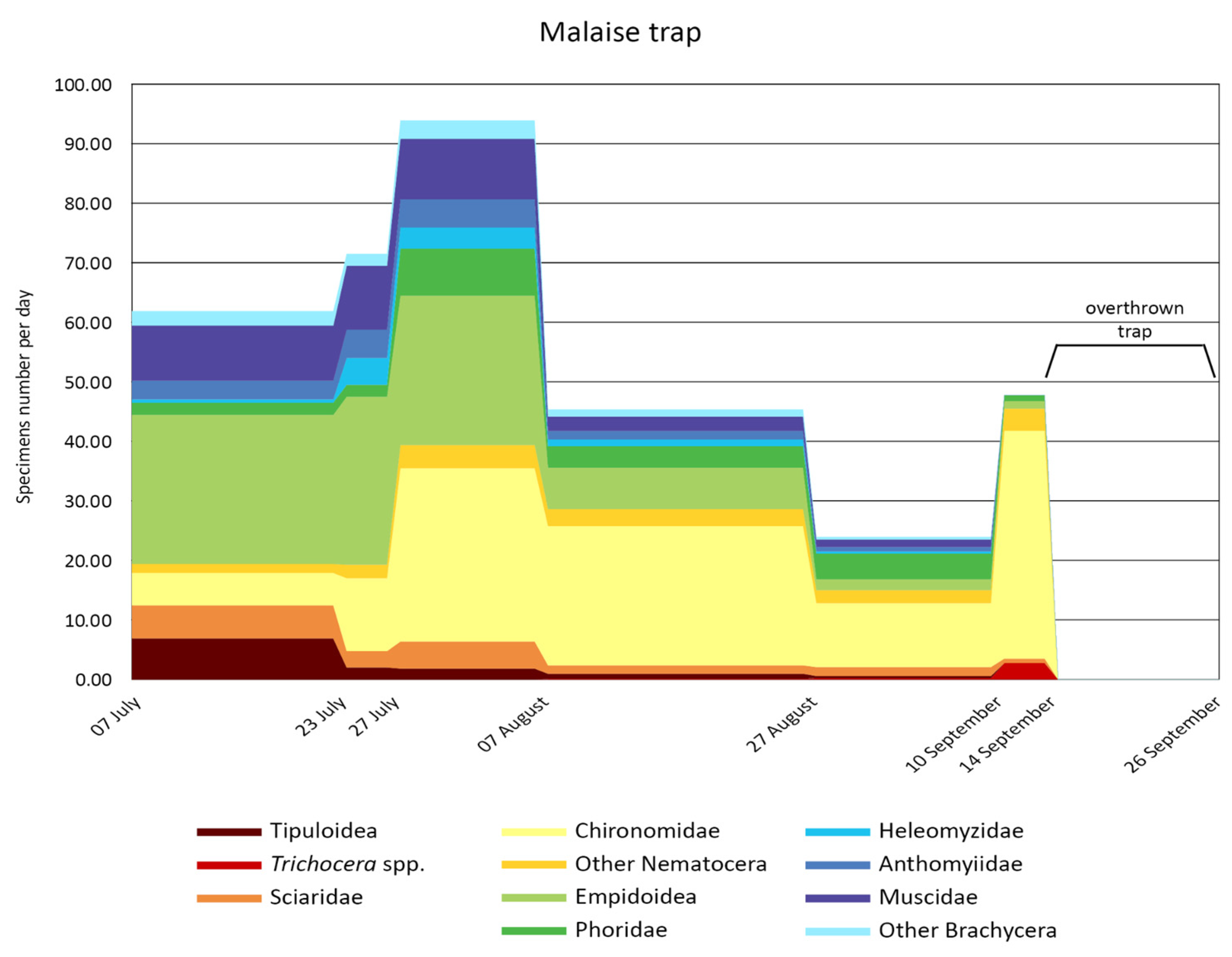

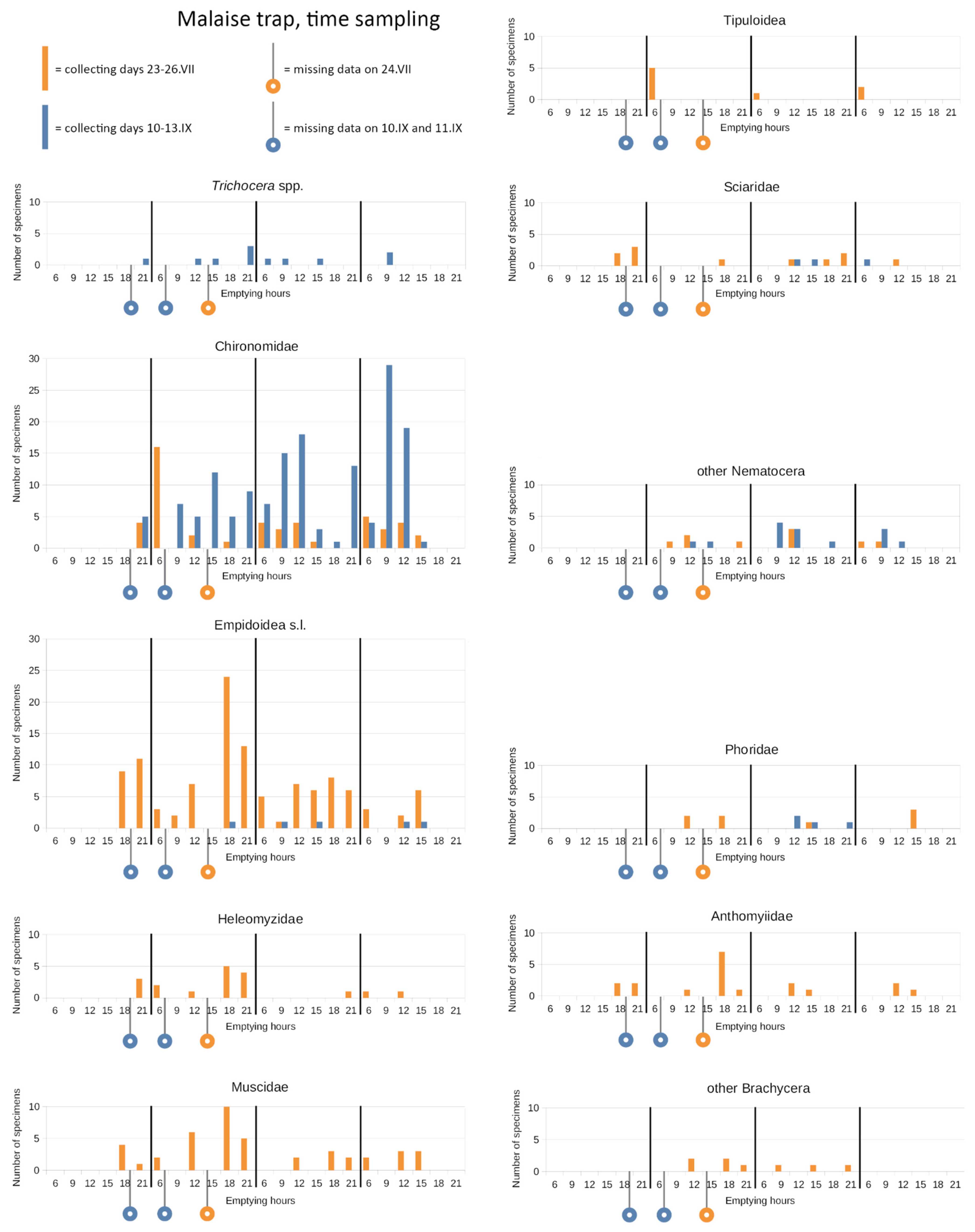

| Diptera Groups | Families | Emergence Traps | Malaise Trap | Drift Sampling | Kick Sampling | Identified Species |
|---|---|---|---|---|---|---|
| NEMATOCERA TIPULOMORPHA | Tipulidae | 1 | 62 | - | - | - |
| Limoniidae | 22 | 81 | 1 | - | - | |
| Pediciidae | 8 | 17 | - | - | ||
| Trichoceridae (Trichocera Meigen, 1803) | 22 | 17 | 2 | - | - | |
| OTHER NEMATOCERA | Bibionidae (Bibio Geoffroy, 1762) | 2 | 1 | - | - | - |
| Mycetophilidae | 3 | 61 | - | - | - | |
| Sciaridae | 15 | 213 | 9 | 11 | - | |
| Cecidomyiidae | - | 2 | - | 1 | - | |
| Psychodidae | 3 | 64 | 1 | 2 | - | |
| Scatopsidae | - | 3 | - | - | - | |
| Thaumaleidae | - | 36 | - | - | - | |
| Simuliidae | 6 | 10 | - | 2 | - | |
| Ceratopogonidae | 1 | 2 | - | 1 | - | |
| Chironomidae | 210 | 1238 | 70 | 41 | - | |
| LOWER BRACHYCERA | Rhagionidae | - | 13 | - | - | |
| Empididae s.l. | 13 | 933 | 4 | 2 | - | |
| Dolichopodidae | 7 | 26 | - | - | - | |
| Phoridae | 8 | 267 | 1 | 2 | - | |
| Lonchopteridae | 7 | 12 | - | - | 2 | |
| Syrphidae | - | 15 | - | - | 10 | |
| BRACHYCERA ACALYPTRATAE | Psilidae | - | 4 | - | - | - |
| Tephritidae | - | 2 | - | - | 2 | |
| Lauxaniidae | - | 1 | - | - | - | |
| Chamaemyiidae | - | 2 | - | - | - | |
| Sciomyzidae | - | 13 | - | - | - | |
| Sepsidae | 3 | 5 | - | - | 3 | |
| Agromyzidae | 2 | 7 | - | - | - | |
| Asteiidae | 1 | - | - | - | - | |
| Chloropidae | 1 | 7 | - | 1 | - | |
| Heleomyzidae | 13 | 93 | - | - | 7 | |
| Sphaeroceridae | 9 | 5 | - | 1 | - | |
| Drosophilidae | 10 | 10 | 1 | 2 | - | |
| Ephydridae | 3 | 6 | - | - | - | |
| BRACHYCERA CALYPTRATAE | Scathophagidae | - | 3 | - | - | - |
| Anthomyiidae | 6 | 161 | - | - | - | |
| Muscidae | 14 | 372 | - | - | 29 | |
| Calliphoridae Rhinophorinae | - | 2 | - | - | - | |
| Tachinidae | - | 4 | - | - | 2 |
Disclaimer/Publisher’s Note: The statements, opinions and data contained in all publications are solely those of the individual author(s) and contributor(s) and not of MDPI and/or the editor(s). MDPI and/or the editor(s) disclaim responsibility for any injury to people or property resulting from any ideas, methods, instructions or products referred to in the content. |
© 2024 by the authors. Licensee MDPI, Basel, Switzerland. This article is an open access article distributed under the terms and conditions of the Creative Commons Attribution (CC BY) license (https://creativecommons.org/licenses/by/4.0/).
Share and Cite
Avesani, D.; Frizzera, D.; Lo Giudice, G.; Birtele, D.; Lencioni, V. Diptera Dwelling Aquatic and Terrestrial Habitats in an Alpine Floodplain (Amola Glacier, Italian Alps). Insects 2024, 15, 904. https://doi.org/10.3390/insects15110904
Avesani D, Frizzera D, Lo Giudice G, Birtele D, Lencioni V. Diptera Dwelling Aquatic and Terrestrial Habitats in an Alpine Floodplain (Amola Glacier, Italian Alps). Insects. 2024; 15(11):904. https://doi.org/10.3390/insects15110904
Chicago/Turabian StyleAvesani, Daniele, Davide Frizzera, Giuseppe Lo Giudice, Daniele Birtele, and Valeria Lencioni. 2024. "Diptera Dwelling Aquatic and Terrestrial Habitats in an Alpine Floodplain (Amola Glacier, Italian Alps)" Insects 15, no. 11: 904. https://doi.org/10.3390/insects15110904
APA StyleAvesani, D., Frizzera, D., Lo Giudice, G., Birtele, D., & Lencioni, V. (2024). Diptera Dwelling Aquatic and Terrestrial Habitats in an Alpine Floodplain (Amola Glacier, Italian Alps). Insects, 15(11), 904. https://doi.org/10.3390/insects15110904







